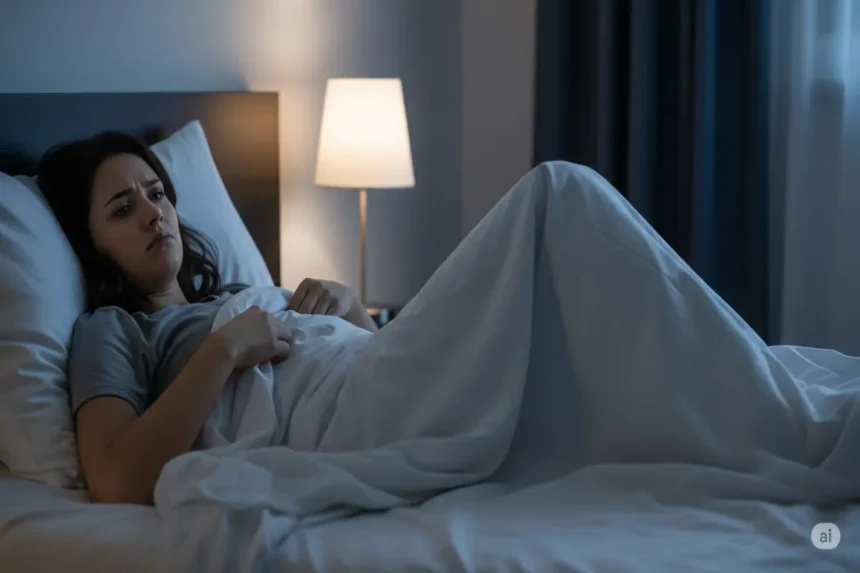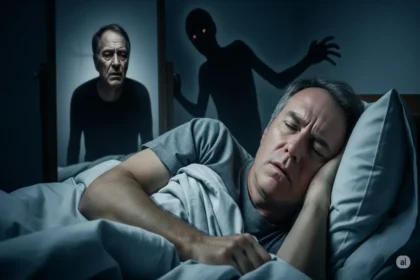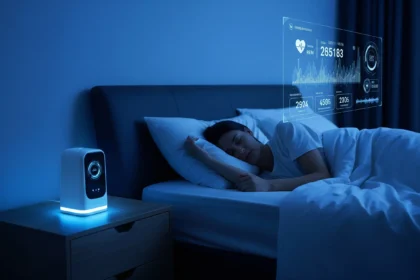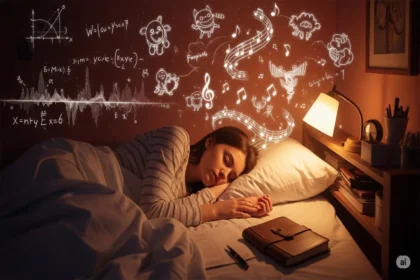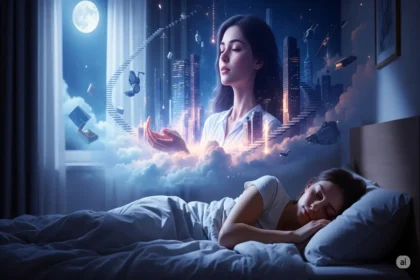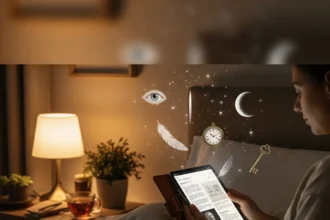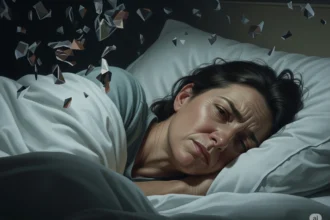Imagine settling into bed after a long day, yearning for the peace of sleep, only to be met by an irresistible, almost maddening urge to move your legs. It’s not just a twitch or a cramp; it’s a deep, unsettling sensation—often described as creeping, crawling, tingling, aching, or even an electric current—that intensifies with rest and finds its only temporary relief in movement. This perplexing neurological disorder, known as Restless Legs Syndrome (RLS), or Willis-Ekbom Disease, is far more than a mere nocturnal annoyance. It’s a chronic condition that profoundly disrupts sleep, erodes quality of life, and leaves millions battling an invisible enemy that keeps them awake, night after night.
Consider Sarah, a retired teacher, who for years dismissed her nightly leg sensations as “just nerves” or “old age.” She’d spend hours tossing and turning, getting out of bed to pace the hallway, or constantly stretching her legs, desperate for relief. Her husband, though sympathetic, often woke to her restless movements. Sarah’s days were shadowed by profound fatigue, irritability, and a constant brain fog that made her beloved hobbies feel impossible. It wasn’t until she finally consulted a sleep specialist that she received a diagnosis of RLS, unlocking the door to understanding and, eventually, managing her elusive nighttime torment. Sarah’s story is a common one, highlighting the often-delayed diagnosis and the pervasive impact of RLS.
Unpacking the Urge: What is Restless Legs Syndrome?
Restless Legs Syndrome is classified as a neurological sensory-motor disorder. The hallmark of RLS is the compelling, often overwhelming, urge to move the legs, usually accompanied by uncomfortable and often painful sensations in the lower limbs. While the sensations are most commonly felt in the calves, thighs, or feet, they can also affect the arms or other parts of the body.
The symptoms of RLS typically follow a specific pattern:
- Urge to Move: An irresistible, often overwhelming, urge to move the affected limb(s).
- Onset/Worsening with Rest: Symptoms begin or worsen during periods of rest or inactivity, such as sitting, lying down, or trying to fall asleep.
- Relief with Movement: Symptoms are partially or totally relieved by movement, like walking, stretching, or rubbing the legs. The relief is often temporary, and the symptoms return once movement ceases.
- Evening/Night Worsening: Symptoms are typically worse in the evening or at night, making it incredibly difficult to fall asleep or stay asleep.
These four criteria (the “URGE” criteria) are essential for a clinical diagnosis of RLS.
The Brain’s Role: Unraveling the Causes
The exact cause of RLS is not fully understood, but scientific research points to several key factors, primarily involving the brain’s neurotransmitter systems and iron regulation.
1. Dopamine Imbalance: The Primary Suspect
The leading theory suggests that RLS is linked to a dysfunction in the brain’s dopamine system. Dopamine is a neurotransmitter that plays a crucial role in regulating movement, mood, and pleasure. In RLS, it’s not necessarily a lack of dopamine, but rather a problem with how the brain uses or processes dopamine, particularly in certain brain regions like the basal ganglia, which are involved in motor control. This explains why symptoms worsen during rest (when dopamine activity naturally decreases) and improve with movement (which temporarily increases dopamine release). It also explains why medications that increase dopamine activity are often effective treatments.
2. Iron Deficiency: A Critical Connection
Iron plays a vital role in the production and function of dopamine in the brain. Even iron levels that are considered “normal” in a standard blood test might be insufficient for optimal brain dopamine function in individuals predisposed to RLS. Low iron stores in the brain, rather than systemic iron deficiency (anemia), are thought to be particularly relevant. This is why iron supplementation is often a first-line treatment for RLS, especially if blood tests reveal low ferritin levels (a measure of the body’s iron stores).
3. Genetics: A Family Affair
RLS often runs in families, indicating a strong genetic component. Approximately 50-60% of individuals with RLS have a family history of the condition, particularly if symptoms began before age 40. Several genes have been identified that are associated with an increased risk of RLS, further supporting its hereditary nature.
4. Secondary RLS: Underlying Conditions
In some cases, RLS can be secondary to other medical conditions or factors. These include:
- Kidney Disease (End-Stage Renal Disease): RLS is common in patients undergoing dialysis.
- Pregnancy: RLS symptoms frequently appear or worsen during the third trimester of pregnancy, often resolving after delivery. Hormonal changes and temporary iron deficiency are thought to play a role.
- Peripheral Neuropathy: Nerve damage in the legs can sometimes contribute to RLS-like symptoms.
- Certain Medications: Some drugs can trigger or worsen RLS, including certain antidepressants (SSRIs, SNRIs), antihistamines, anti-nausea drugs, and cold/allergy medications.
The Unseen Burden: Impact on Sleep and Life
The most significant impact of RLS is on sleep. The irresistible urge to move, particularly at night, makes it incredibly difficult to fall asleep and stay asleep. This leads to chronic sleep deprivation, with far-reaching consequences:
- Insomnia: RLS is a leading cause of chronic insomnia, as individuals spend hours tossing, turning, and moving their legs in a desperate attempt to find relief.
- Daytime Fatigue: Persistent sleep deprivation results in overwhelming daytime tiredness, fatigue, and lethargy.
- Cognitive Impairment: Brain fog, difficulty concentrating, memory problems, and impaired decision-making are common.
- Mood Disturbances: Chronic sleep loss and the frustration of RLS significantly increase the risk of depression, anxiety, and irritability.
- Reduced Quality of Life: The constant discomfort and sleep disruption can severely impact work performance, social activities, relationships, and overall well-being. Simple activities like sitting through a movie, a long car ride, or a meeting can become unbearable.
Diagnosing RLS: A Clinical Puzzle
Diagnosing RLS is primarily clinical, based on the patient’s description of their symptoms. There is no single blood test or diagnostic imaging that can confirm RLS. A thorough medical history and physical examination are crucial.
Key diagnostic criteria (the URGE criteria, as mentioned above) guide the process. Doctors will also inquire about:
- Family History: To assess for a genetic component.
- Medication Review: To identify any drugs that might be triggering or worsening symptoms.
- Blood Tests: To check for underlying conditions, particularly iron deficiency (ferritin levels), kidney function, and thyroid issues.
- Polysomnography (Sleep Study): While not typically used to diagnose RLS directly, a sleep study might be performed to rule out other sleep disorders (like sleep apnea) that can mimic or co-exist with RLS, or to identify Periodic Limb Movements in Sleep (PLMS). PLMS are involuntary, repetitive leg (and sometimes arm) jerks that occur during sleep. While many RLS patients have PLMS, PLMS can also occur independently.
Managing the Urge: Solutions for Better Sleep
While there is no cure for RLS, effective treatments and management strategies can significantly alleviate symptoms and improve sleep quality. A multi-pronged approach, often involving lifestyle changes and medication, is usually most successful.
1. Lifestyle Modifications: The Foundation of Relief
These are often the first line of defense and can provide significant relief for many individuals:
- Regular, Moderate Exercise: Consistent physical activity, particularly walking or cycling, can help. However, avoid intense exercise too close to bedtime, as it can sometimes worsen symptoms.
- Avoid Triggers:
- Caffeine: Limit or eliminate caffeine, especially in the afternoon and evening.
- Alcohol: Reduce or avoid alcohol, as it can disrupt sleep and worsen RLS.
- Nicotine: Quitting smoking can improve RLS symptoms.
- Certain Medications: Review your medication list with your doctor. If possible, avoid or switch medications known to exacerbate RLS (e.g., some antihistamines, antidepressants, anti-nausea drugs).
- Establish a Consistent Sleep Schedule: Go to bed and wake up at the same time every day, even on weekends. This helps regulate your body’s natural rhythms.
- Optimize Sleep Environment: Ensure your bedroom is dark, quiet, and cool.
- Relaxing Bedtime Routine: Engage in calming activities before bed, such as a warm bath (the warmth can temporarily soothe symptoms), gentle stretching, massage, or meditation.
- Leg Massage/Stretching: Massaging the affected legs or performing gentle stretches before bed or during an episode can provide temporary relief.
- Hot or Cold Packs: Some individuals find relief from applying hot or cold packs to their legs.
2. Iron Supplementation: Addressing the Deficiency
If blood tests reveal low ferritin levels (even if not anemic), iron supplementation is often prescribed. It’s crucial to take iron supplements under medical supervision, as excessive iron can be harmful. The effects of iron supplementation on RLS symptoms may take several weeks or months to become apparent.
3. Medications: Targeted Relief
For moderate to severe RLS, medications are often necessary. These typically target the dopamine system:
- Dopaminergic Agents: These medications, such as pramipexole (Mirapex), ropinirole (Requip), and rotigotine (Neupro patch), increase dopamine activity in the brain. They are often very effective in reducing RLS symptoms. However, long-term use can sometimes lead to “augmentation,” where symptoms worsen or spread to other body parts.
- Alpha-2 Delta Ligands: Medications like gabapentin (Neurontin) and pregabalin (Lyrica) are increasingly used as first-line treatments, especially for RLS with painful symptoms or when dopaminergic agents cause augmentation. They work by affecting calcium channels in the nervous system.
- Benzodiazepines: Drugs like clonazepam (Klonopin) may be used in some cases to promote sleep, but they do not treat the underlying RLS symptoms and can have side effects like daytime drowsiness and dependence. They are generally used with caution.
- Opioids: For severe RLS that doesn’t respond to other treatments, low doses of opioids may be considered, but this is typically a last resort due to the risk of dependence.
Living with RLS: Finding Your Path to Peace
Living with Restless Legs Syndrome requires patience, self-awareness, and a proactive approach to management. It’s about finding the combination of lifestyle adjustments and, if necessary, medications that work best for you. Open communication with your doctor is key, as treatment plans may need to be adjusted over time.
Connecting with support groups or online communities can also be invaluable. Sharing experiences with others who understand the unique challenges of RLS can reduce feelings of isolation and provide practical coping strategies. Educating family and friends about the condition can foster understanding and support, transforming frustration into empathy.
Conclusion: Reclaiming the Quiet Night
Restless Legs Syndrome is a complex and often debilitating neurological disorder that can steal the peace of the night and the vitality of the day. The relentless urge to move, coupled with uncomfortable sensations, creates a profound barrier to restorative sleep, impacting physical health, mental well-being, and overall quality of life.
However, the scientific understanding of RLS has advanced significantly, offering hope and effective solutions. By recognizing the symptoms, seeking an accurate diagnosis, and embracing a personalized management plan that may include lifestyle changes, addressing iron levels, and targeted medications, individuals can find significant relief. Reclaiming the quiet of the night from the grip of RLS is not just about silencing an urge; it’s about restoring the fundamental human need for restful sleep, allowing individuals to wake up refreshed, re-energized, and ready to embrace life with renewed vigor. It’s a journey towards profound peace, one still night at a time.
Disclaimer: The information provided in this article is for general informational purposes only and does not constitute medical advice. It is not a substitute for professional medical advice, diagnosis, or treatment. Always seek the advice of your physician or other qualified health provider with any questions you may have regarding a medical condition. Never disregard professional medical advice or delay in seeking it because of something you have read on this website.

